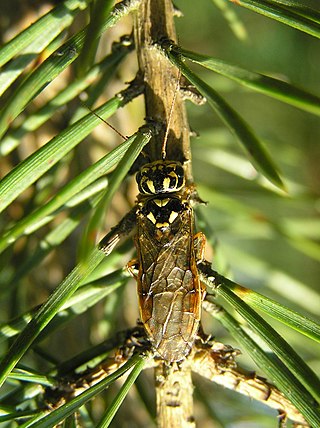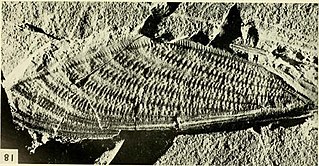
The froghoppers, or the superfamily Cercopoidea, are a group of hemipteran insects in the suborder Auchenorrhyncha. Adults are capable of jumping many times their height and length, giving the group their common name, but many species are best known for their plant-sucking nymphs which produce foam shelters, and are referred to as "spittlebugs".

The Trachypachidae are a family of beetles that generally resemble small ground beetles, but that are distinguished by the large coxae of their rearmost legs. There are only six known extant species in the family, with four species of Trachypachus found in northern Eurasia and northern North America, and two species of Systolosoma in Chile and Argentina. They were much more diverse in the past, with dozens of described species from the Mesozoic.

Weald Clay or the Weald Clay Formation is a Lower Cretaceous sedimentary rock unit underlying areas of South East England, between the North and South Downs, in an area called the Weald Basin. It is the uppermost unit of the Wealden Group of rocks within the Weald Basin, and the upper portion of the unit is equivalent in age to the exposed portion of the Wessex Formation on the Isle of Wight. It predominantly consists of thinly bedded mudstone. The un-weathered form is blue/grey, and the yellow/orange is the weathered form, it is used in brickmaking.

The Tettigarctidae, known as the hairy cicadas, are a small relict family of primitive cicadas. Along with more than 20 extinct genera, Tettigarctidae contains a single extant genus, Tettigarcta, with two extant species, one from southern Australia and one from the island of Tasmania. Numerous fossil species have been described from the Late Triassic onwards. Tettigarcta are the closest living relatives of the true cicadas.

A planthopper is any insect in the infraorder Fulgoromorpha, in the suborder Auchenorrhyncha, a group exceeding 12,500 described species worldwide. The name comes from their remarkable resemblance to leaves and other plants of their environment and that they often "hop" for quick transportation in a similar way to that of grasshoppers. However, planthoppers generally walk very slowly. Distributed worldwide, all members of this group are plant-feeders, though few are considered pests. The infraorder contains only a single superfamily, Fulgoroidea. Fulgoroids are most reliably distinguished from the other Auchenorrhyncha by two features; the bifurcate (Y-shaped) anal vein in the forewing, and the thickened, three-segmented antennae, with a generally round or egg-shaped second segment (pedicel) that bears a fine filamentous arista.

The Pamphilioidea are a small superfamily within the Symphyta, containing some 250 living species restricted to the temperate regions of Eurasia and North America. These hymenopterans share the distinctive feature of a very large, almost prognathous head, which is widest ventrally.

Jurodidae is a family of beetles that was originally described for the extinct genus Jurodes, known from the Middle-Late Jurassic of Asia. In 1996, a living species, Sikhotealinia zhiltzovae was discovered in the Sikhote-Alin mountains in southeastern Siberia, and assigned to this family. Their placement is uncertain, but are usually considered archostematans. In one study, Sikhotealinia and Jurodes were considered a sister group to all other archostematan beetles. However, other authors have considered their placement within beetles as a whole uncertain, due to their mix characteristics of typical Archostemata, as well as Polyphaga and Adephaga.

Coleorrhyncha or Peloridiomorpha, also known as moss bugs or beetle bugs, are a suborder of Hemiptera and represent an ancient lineage of moss-feeding insects. They show some similarities to the Heteroptera but have been considered distinct. It has a single extant family, the Peloridiidae. They are 2 to 5 millimetres in length, and feed on moss and liverworts. They have wings in some species which are reduced in others but all species are flightless and live in damp moss habitats and are associated with the distribution of Nothofagus trees in Australia, New Zealand, New Caledonia, and South America, which all were formerly part of the supercontinent Gondwana.

Palaeontinidae, commonly known as giant cicadas, is an extinct family of cicadomorphs. They existed from the Late Triassic to the Early Cretaceous. The family contains around 30 to 40 genera and around a hundred species.

Palaeontinoidea is an extinct superfamily of cicadomorph hemipteran insects. This superfamily contains three families.

Nogodinidae is a family of planthoppers. They have membranous wings with delicate venation and can be confused with members of other Fulgoroid families such as the Issidae and Tropiduchidae. Some authors treat it as a subfamily of the Issidae. Some of their key features are a frons ("face") that is longer than wide and a reticulate wing venation. They are less than 2 cm long. The antenna arises well below the eye, has the base clubbed and flagellum unsegmented. The lateral ocelli are outside the margins of the face. The face has carinae on the edge. On the hind leg, the second tarsal segment has an apical spine arising from it. The tibia of the hind leg also has spines towards the tip. An important family character is found in the shape of the male genital structure, a style that is longer than broad. Most members of this family are forest species.
The Progonocimicidae are an extinct family of true bugs in the suborder Coleorrhyncha. Progonocimicidae fossils have been found in Europe, Asia, Australia, and South America.
2018 in paleoentomology is a list of new fossil insect taxa that were described during the year 2018, as well as other significant discoveries and events related to paleoentomology that were scheduled to occur during the year.
2019 in paleoentomology is a list of new fossil insect taxa that were described during the year 2019, as well as other significant discoveries and events related to paleoentomology that were scheduled to occur during the year.
2015 in paleoentomology is a list of new fossil insect taxa that were described during the year 2015, as well as other significant discoveries and events related to paleoentomology that were scheduled to occur during the year.

Mimarachnidae is an extinct family of planthoppers known from the Cretaceous period. Their name is derived from spots on the wings of the first described genera, Mimarachne and Saltissus, being suggestive of spider mimicry, but these characters are not distinctive for the family as a whole. The family is characterised by "simplified venation and setigerous metatibial pecten and hind leg armature". as well as "rounded anterior margin of pronotum, double carination of pronotum and mesonotum"

Sinoalidae is an extinct family of froghoppers known from the late Middle Jurassic to the early Late Cretaceous of Asia. They are one of two main Mesozoic families of froghoppers, alongside Procercopidae, unlike Procercopidae, Sinoalidae is thought to be an extinct side branch and not ancestral to modern froghoppers. Sinoalids have a temporally disjunct distribution being only known from the late Middle Jurassic (Callovian) Yanliao Biota of Inner Mongolia and the early Late Cretaceous (Cenomanian) aged Burmese amber of Myanmar, separated by over 60 million years. The family is "recognized by its tegmen with the costal area and clavus commonly more sclerotized and punctate than the remaining part, and its hind tibia with two rows of lateral spines"
Perforissidae is an extinct family of planthoppers. They are considered to belong to the group of "Cixiidae-like" planthoppers. Species are known from the Early to Late Cretaceous of Eurasia, North America and South America. The family was named by Shcherbakov in 2007
Fulgoridiidae are an extinct family of Mesozoic planthoppers. They are the earliest group of planthoppers known, and appear to be a paraphyletic assemblage ancestral to living planthoppers. The majority of known members of the family lived in the Jurassic period, though the group also includes one Cretaceous taxon. All currently known species are from Eurasia.
Szeiinia is an extinct genus of planthoppers from the Late Triassic of China. It was named by Zhang, Jiang, Szwedo, and Zhang in 2021, and is the only genus of the family Szeiiniidae. It itself comprises the single species Szeiinia huanglongensis.












